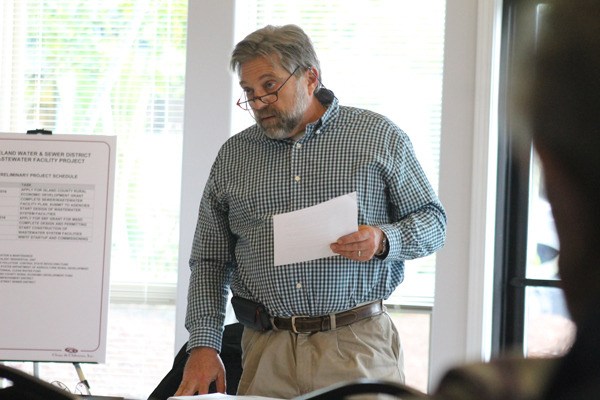The Freeland Water and Sewer District’s $10.5 million plan to bring sewers to Freeland’s commercial core was received with general approval by property owners at a recent informational meeting.
A project about two years in the making, officials plan to design, construct and operate a sewer system in accordance to the Growth Management Act, which requires urbanized rural areas to plan and work toward urban services within a 20-year period. Tuesday night’s meeting at Whidbey Water Services was meant to gauge whether residents would be on board with having to pay $2.5 million of the proposed project. Commissioner Eric Hansen said that attendees were generally supportive of the project, though they did have questions that included nitrates in ground water, potential noise and odor emitted from a sewer treatment plant and quality of drinking water.
“We were looking for more engagement by the community and we got it,” Hansen said after the meeting. “The property owners in general were supportive — not everybody — but in general there seems to be support for it and that’s what we need.”
 Hansen, commissioners Lou Malzone and John Brunke, and Gray & Osborne Engineering Consultant Roger Kuykendall spoke during the first half of the meeting and provided attendees with the history and background of the project as well as updates. They plan to install sewers in the downtown core first, with west Freeland following in a second and later phase.
Hansen, commissioners Lou Malzone and John Brunke, and Gray & Osborne Engineering Consultant Roger Kuykendall spoke during the first half of the meeting and provided attendees with the history and background of the project as well as updates. They plan to install sewers in the downtown core first, with west Freeland following in a second and later phase.
“The objective here is to get something started and that’s why were focusing just on the downtown core area,” Hansen said during the meeting.
A future project would address concerns that septic drainfields in the downtown area could be threatening Freeland’s wells, located south of Highway 525. Hansen said the district has seen a general migration of nitrate from the downtown core toward the wells.
“We’re not going to do it until there’s a demand for it and until funding is available,” Hansen said. “It’s a go-slower approach than what we had about four or five years ago.”
Kuykendall explained the design plans for a sewer treatment plant on a 24-acre property previously owned by Jerry Stonebridge. The district purchased it for $800,000 last year. He said the plant will address two things: the removal of increasing levels of nitrates in groundwater, and to protect the infiltration system from being plugged or clogged with fine materials.
“The water that’s going to come out of the system is going to be very, very clean,” Kuykendall said.
Through a series of wells, drilled 40-feet deep and fitted with perforated pipes, they will be above the aquifer where it will be discharged into soil underneath. Kuykendall said a majority of the odors will be enclosed and sent through a carbon filtration system before being discharged to the outside air. He said most of the systems aren’t noisy. A required backup generator will be exercised once a month. Otherwise, most of the pumps are underground or inside an enclosed building, but that noise won’t be much of an issue, he said.
Malzone spoke on his efforts to acquire funding for the project. He’s worked with property owners, Island County commissioners and the state. Brunke followed with an assessment of the next steps ahead for the district.
Hansen said there were no surprise questions asked by the attendees. He noted that some questions implied the need to do certain things, as opposed to holding the project back.
“We only heard one dissent actually,” Hansen said.
The lone dissenter, retired Freeland Clinic owner Patrice O’Neill, was concerned how the proposal will affect property values.
“I’ve practiced for 42 and a half years here,” O’Neill said. “It’s my building. Now I would like to get out. I would like to be able to sell that building, but how do I go sell it to somebody saying I don’t know how much of this obligation you’re going to have.”
“The whole bit about the water and all the rest of that, that is absolutely right,” she added.
Whidbey Telecom Co-CEO George Henny sounded off in approval of the project at the meeting.
“Frankly, it’s the best solution I’ve yet to see,” Henny said. “Is it perfect? No, I’m sure it’s not. But is it the best one we’re likely to see? We should assess that as a ‘yes.’ ”
“Personally, I’m willing to put my foot forward in support of this,” he added.
Hansen said it’s significant that the larger property owners are on board with the project, considering they will likely pay a larger fraction of the $2.5 million.
“It’s the larger property owners that are likely to get the biggest fraction of that $2.5 million,” Hansen said. “So it is important. It’s very important.”
The figure is a scenario in which the water district will secure approximately $4.5 million in additional grant funding. It’s already secured about $3.5 million in state grant funding, money that has paid for the Stonebridge property and a $450,000 contract last month with Olympia-based Gray & Osbourne Consulting Engineers, Inc. for design of the sewer plant.
The commissioners will continue focusing on funding the project with money from state agencies such as the Department of Ecology, and local coffers like Island County, Hansen said.
“We can get legislative provisos that provide us money through our county commissioners, who can steer grant money our way,” Hansen said. “Remember, we’re doing this on behalf of the county. We’re really looking for solid support from our county on this.”
A topographic survey is also underway.


